Buick LaCrosse 2018 Owner's Manual
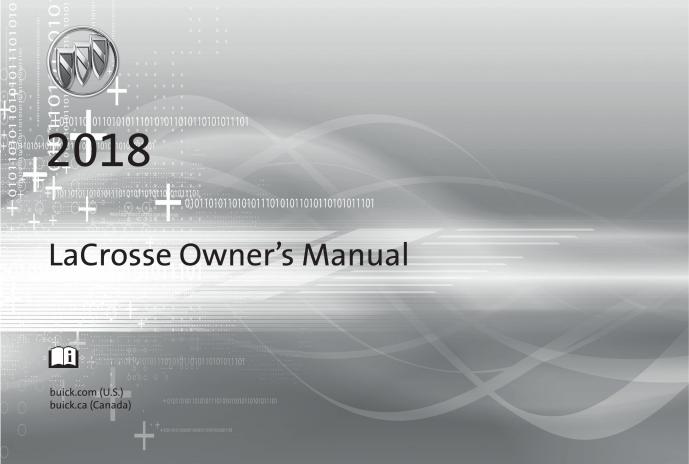

Contents
Introduction . . . . . . . . . . . . . . . . . . . . . . 2
In Brief . . . . . . . . . . . . . . . . . . . . . . . . . . . 5
Keys, Doors, and Windows . . . . . 27
Seats and Restraints . . . . . . . . . . . 51
Storage . . . . . . . . . . . . . . . . . . . . . . . 100
Instruments and Controls . . . . . . 103
Lighting . . . . . . . . . . . . . . . . . . . . . . . 144
Infotainment System . . . . . . . . . . 151
Climate Controls . . . . . . . . . . . . . . 152
Driving and Operating . . . . . . . . . 159
Vehicle Care . . . . . . . . . . . . . . . . . . 227
Service and Maintenance . . . . . 310
Technical Data . . . . . . . . . . . . . . . . 322
Customer Information . . . . . . . . . 325
Reporting Safety Defects . . . . . . 335
OnStar . . . . . . . . . . . . . . . . . . . . . . . . 339
Index . . . . . . . . . . . . . . . . . . . . 350

2Introduction
Introduction
The names, logos, emblems, slogans, vehicle model names, and vehicle body designs appearing in this manual including, but not limited to, GM, the GM logo, BUICK, the BUICK Emblem, and LACROSSE are trademarks and/or service marks of General Motors LLC, its subsidiaries, affiliates, or licensors.
For vehicles first sold in Canada, substitute the name “General Motors of Canada Company” for Buick Motor Division wherever it appears in this manual.
Litho in U.S.A.
Part No. 23271914 A First Printing
This manual describes features that may or may not be on the vehicle because of optional equipment that was not purchased on the vehicle, model variants, country specifications, features/applications that may not be available in your region, or changes subsequent to the printing of this owner’s manual.
Refer to the purchase documentation relating to your specific vehicle to confirm the features.
Keep this manual in the vehicle for quick reference.
Canadian Vehicle Owners
A French language manual can be obtained from your dealer, at www.helminc.com, or from:
Propriétaires Canadiens
On peut obtenir un exemplaire de ce guide en français auprès du concessionnaire ou à l'adresse suivante:
Helm, Incorporated
Attention: Customer Service
47911 Halyard Drive
Plymouth, MI 48170
USA
Using this Manual
To quickly locate information about the vehicle, use the Index in the back of the manual. It is an alphabetical list of what is in the manual and the page number where it can be found.
Danger, Warning, and
Caution
Warning messages found on vehicle labels and in this manual describe hazards and what to do to avoid or reduce them.
© 2017 General Motors LLC. All Rights Reserved.

Introduction 3
{Danger
Danger indicates a hazard with a high level of risk which will result in serious injury or death.
{Warning
Warning indicates a hazard that could result in injury or death.
Caution
Caution indicates a hazard that could result in property or vehicle damage.
A circle with a slash through it is a safety symbol which means “Do Not,” “Do not do this,” or “Do not let this happen.”
Symbols
The vehicle has components and labels that use symbols instead of text. Symbols are shown along with the text describing the operation or information relating to a specific component, control, message, gauge, or indicator.
M : Shown when the owner’s manual has additional instructions or information.
* : Shown when the service manual has additional instructions or information.
0 : Shown when there is more information on another page — “see page.”
Vehicle Symbol Chart
Here are some additional symbols that may be found on the vehicle and what they mean. See the features in this manual for information.
9 : Airbag Readiness Light
# : Air Conditioning
! : Antilock Brake System (ABS)
$ : Brake System Warning Light
" : Charging System (12-Volt
Battery)
I : Cruise Control
` : Do Not Puncture
^ : Do Not Service
B : Engine Coolant Temperature
O : Exterior Lamps
g : First Responder
_ : Flame/Fire Prohibited
. : Fuel Gauge
+ : Fuses
3 : Headlamp High/Low-Beam
Changer
_ : High Voltage
j : LATCH System Child Restraints
* : Malfunction Indicator Lamp
: : Oil Pressure
O : Power

4Introduction
/ : Remote Vehicle Start
> : Seat Belt Reminders
7 : Tire Pressure Monitor
d : Traction Control/StabiliTrak
a : Under Pressure
M : Windshield Washer Fluid

In Brief |
5 |
|
|
In Brief
Instrument Panel
Instrument Panel . . . . . . . . . . . . . . . . 6
Initial Drive Information
Initial Drive Information . . . . . . . . . . 8
Stop/Start System . . . . . . . . . . . . . . . 8
Remote Keyless Entry (RKE)
System . . . . . . . . . . . . . . . . . . . . . . . . 8
Remote Vehicle Start . . . . . . . . . . . 8
Door Locks . . . . . . . . . . . . . . . . . . . . . 9
Trunk Release . . . . . . . . . . . . . . . . . . 9
Windows . . . . . . . . . . . . . . . . . . . . . . . 10
Seat Adjustment . . . . . . . . . . . . . . . 10
Memory Features . . . . . . . . . . . . . . 11
Heated and Ventilated Seats . . . 12
Head Restraint Adjustment . . . . 12
Seat Belts . . . . . . . . . . . . . . . . . . . . . 13
Passenger Sensing System . . . 13
Mirror Adjustment . . . . . . . . . . . . . . 13
Steering Wheel Adjustment . . . . 14
Interior Lighting . . . . . . . . . . . . . . . . 15
Exterior Lighting . . . . . . . . . . . . . . . 16
Windshield Wiper/Washer . . . . . . 16
Climate Controls . . . . . . . . . . . . . . . 17
Transmission . . . . . . . . . . . . . . . . . . 18
Vehicle Features
Infotainment System . . . . . . . . . . . 18
Steering Wheel Controls . . . . . . . 18
Cruise Control . . . . . . . . . . . . . . . . . 18
Driver Information
Center (DIC) . . . . . . . . . . . . . . . . . 19
Forward Collision Alert (FCA)
System . . . . . . . . . . . . . . . . . . . . . . . 19
Forward Automatic
Braking (FAB) . . . . . . . . . . . . . . . . 19
Front Pedestrian Braking (FPB)
System . . . . . . . . . . . . . . . . . . . . . . . 19
Lane Keep Assist (LKA) . . . . . . . 20
Lane Change Alert (LCA) . . . . . . 20
Rear Vision Camera (RVC) . . . . 20
Rear Cross Traffic Alert (RCTA)
System . . . . . . . . . . . . . . . . . . . . . . . 20
Parking Assist . . . . . . . . . . . . . . . . . 20
Automatic Parking
Assist (APA) . . . . . . . . . . . . . . . . . . 21
Power Outlets . . . . . . . . . . . . . . . . . 21
Universal Remote System . . . . . 21
Sunroof . . . . . . . . . . . . . . . . . . . . . . . . 22
eAssist Features
eAssist Overview . . . . . . . . . . . . . . 23
High Voltage Safety
Information . . . . . . . . . . . . . . . . . . . 23
Automatic Engine Stop/Start
Feature . . . . . . . . . . . . . . . . . . . . . . . 23
Regenerative Braking . . . . . . . . . . 24
Battery . . . . . . . . . . . . . . . . . . . . . . . . . 24
Service . . . . . . . . . . . . . . . . . . . . . . . . 24
Performance and Maintenance
Traction Control/Electronic Stability Control . . . . . . . . . . . . . . 24
Tire Pressure Monitor . . . . . . . . . . 25 Fuel . . . . . . . . . . . . . . . . . . . . . . . . . . . 25 E85 or FlexFuel . . . . . . . . . . . . . . . . 25 Engine Oil Life System . . . . . . . . 25 Driving for Better Fuel
Economy . . . . . . . . . . . . . . . . . . . . . 26 Roadside Assistance
Program . . . . . . . . . . . . . . . . . . . . . . 26

6In Brief
Instrument Panel
Instrument Panel Overview

In Brief |
7 |
|
|
1.Air Vents 0 157.
2.Exterior Lamp Controls 0 144.
Fog Lamps 0 147.
Instrument Panel Illumination Control 0 148.
3.Turn and Lane-Change Signals 0 147.
4.Tap Shift Controls (If Equipped). See Manual Mode
0 185.
5.Instrument Cluster 0 110.
Driver Information Center (DIC) Display. See Driver Information Center (DIC) 0 126.
6.Windshield Wiper/Washer 0 105.
7.Hazard Warning Flashers 0 146.
8.Light Sensor. See Automatic Headlamp System 0 145.
9.Infotainment 0 151.
10.Dual Automatic Climate Control System 0 152.
11.Traction Control/Electronic Stability Control 0 190.
Parking Assist Button. See
Driver Assistance Systems 0 203.
SPORT Button (If Equipped). See Selective Ride Control 0 192.
Lane Keep Assist (LKA) 0 216
(If Equipped).
Automatic Parking Assist
Button (If Equipped). See
Driver Assistance Systems
0203.
12.Shift Lever. See Automatic Transmission 0 181.
13.ENGINE START/STOP Button (Out of View). See Ignition Positions 0 170.
14.Steering Wheel Controls. See the infotainment manual.
Driver Information Center (DIC) Controls. See Driver Information Center (DIC) 0 126.
15.Horn 0 105.
16.Steering Wheel Adjustment
0104 (Out of View).
17.Cruise Control 0 193 (If Equipped).
Adaptive Cruise Control 0 195
(If Equipped).
Forward Collision Alert (FCA) System 0 208 (If Equipped).
Heated Steering Wheel 0 104
(If Equipped).
18.Head-Up Display (HUD) 0 129
(If Equipped).
19.Hood Release (Out of View). See Hood 0 230.
20.Front Storage.
21.Data Link Connector (DLC) (Out of View). See Malfunction Indicator Lamp (Check Engine Light) 0 117.
22.Electric Parking Brake 0 188.

8In Brief
Initial Drive
Information
This section provides a brief overview about some of the important features that may or may not be on your specific vehicle.
For more detailed information, refer to each of the features which can be found later in this owner’s manual.
Stop/Start System
The vehicle may be equipped with a fuel saving stop/start system to shut off the engine and help
conserve fuel.
When the brakes are applied and the vehicle is at a complete stop, the engine may turn off. When the brake pedal is released or the accelerator pedal is pushed, the engine will restart.
See Starting the Engine 0 172.
Remote Keyless Entry
(RKE) System
The Remote Keyless Entry (RKE) transmitter may work up to 60 m (197 ft) away from the vehicle.
With Remote Start Shown
Q : Press to lock all doors.
K : Press to unlock the driver door or all doors.
Lock and unlock feedback can be personalized. See Vehicle Personalization 0 133.
X : Press twice quickly to release the trunk.
7 : Press and release to initiate vehicle locator. Press and hold for at least three seconds to sound the panic alarm. Press again to cancel the panic alarm.
See Keys 0 27 and Remote Keyless Entry (RKE) System Operation 0 28.
Remote Vehicle Start
If equipped, the engine can be started from outside of the vehicle.
Starting the Vehicle
1.Press and release Q on the RKE transmitter.
2.Immediately press and hold / for at least four seconds or until the turn signal lamps flash.
Start the vehicle normally after entering.
When the vehicle starts, the parking lamps will turn on.
Remote start can be extended.

In Brief |
9 |
|
|
Canceling a Remote Start
To cancel a remote start, do one of the following:
.Press and hold / until the parking lamps turn off.
.Turn on the hazard warning flashers.
. Turn the vehicle on and then off.
See Remote Vehicle Start 0 34.
Door Locks
To lock or unlock the doors:
.From inside the vehicle, use the power door lock controls. Pull once on the door handle to unlock it, and a second time to open it.
.From outside, press Q or K on the Remote Keyless Entry (RKE) transmitter, or use the key in the door. The key cylinder is covered with a cap. See Remote Keyless Entry (RKE) System Operation 0 28.
See Door Locks 0 36.
Power Door Locks
The power door lock controls are on the front door panels.
K : Press to unlock all doors.
Q : Press to lock all doors.
See Power Door Locks 0 38.
Keyless Access
The RKE transmitter must be within 1 m (3 ft) of the door being opened.
Press the button on the door handle to open. See “Keyless Access Operation” under Remote Keyless Entry (RKE) System Operation 0 28.
Trunk Release
To open the trunk from outside the vehicle, press X twice quickly on the Remote Keyless Entry (RKE) transmitter.
Press the bottom of the emblem above the license plate when all doors are unlocked.
To open the trunk from inside the vehicle, press |on the driver door when the vehicle is off or in P (Park). See Trunk 0 40.
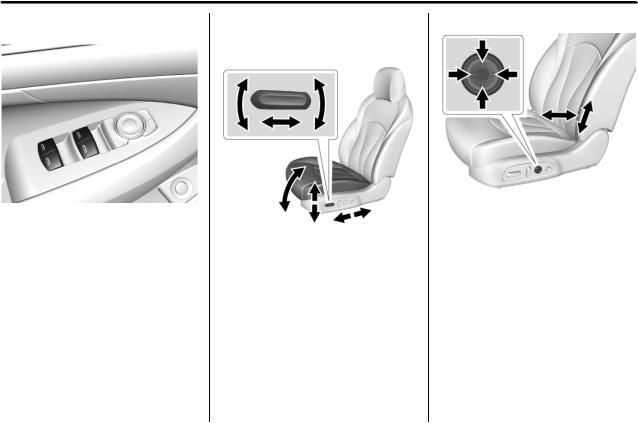
10 In Brief
Windows |
Seat Adjustment |
Lumbar Adjustment |
|
Power Seats |
|
Power windows work when the ignition is on, in ACC/ACCESSORY, or when Retained Accessory Power (RAP) is active. See Retained Accessory Power (RAP) 0 176.
Using the window switch, press to open or pull to close the window.
The windows may be temporarily disabled if they are used repeatedly within a short time.
To adjust the seat:
.Move the seat forward or rearward by moving the control forward or rearward.
.Raise or lower the front part of the seat cushion by moving the front of the control up or down.
.Raise or lower the entire seat by moving the rear of the control up or down.
See Power Seat Adjustment 0 53.
Four-Way Shown, Two-Way
Similar
To adjust the lumbar support, if equipped:
.Press and hold the front or rear of the control to increase or decrease lumbar support.
.If equipped, press and hold the top or bottom of the control to raise or lower lumbar support.
See Lumbar Adjustment 0 54.

In Brief |
11 |
|
|
Massage
If equipped, the ignition must be on to use the massage feature.
If equipped, press the massage button to use the massage feature. To stop massage, press this button again.
The massage feature will turn off after approximately 10 minutes. Press the massage button to restart the massage feature.
Reclining Seatbacks |
Memory Features |
Power Reclining Seatbacks
.Tilt the top of the control rearward to recline.
.Tilt the top of the control forward to raise.
See Reclining Seatbacks 0 54.
If equipped, memory seats allow two drivers to store and recall their unique seat positions for driving the vehicle, and a shared exit position for getting out of the vehicle. Other feature positions may also be set, such as power mirrors and power steering wheel, if equipped. Memory positions are linked to RKE transmitter 1 or 2 for automatic memory recalls.
Before storing, adjust all available memory feature positions. Turn the ignition on and then press and release SET; a beep will sound.
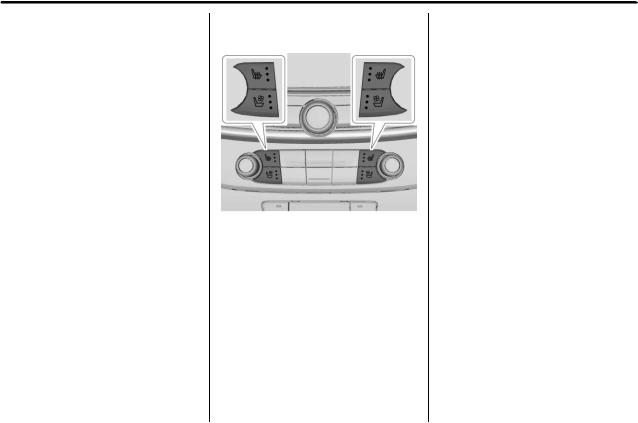
12 In Brief
Then immediately press and hold 1, 2, or B (Exit) on the driver door until two beeps sound. To manually recall these positions, press and hold 1, 2, or B until the saved position is reached.
When Auto Memory Recall is enabled in the personalization menu, positions previously stored to memory buttons 1 and 2 are recalled when the ignition is changed from OFF to ON/RUN or ACC/ACCESSORY.
When Easy Exit Options is enabled in the personalization menu, the feature automatically recalls the previously stored exit position when exiting the vehicle. See Memory Seats 0 55.
Heated and Ventilated
Seats
Heated and Ventilated Seat
Buttons Shown, Heated Seat
Buttons Similar
If equipped, the buttons are near the climate controls on the center stack. To operate, the ignition must be on.
Press M or L to heat the driver or passenger seat cushion.
Press Cor {, if equipped, to ventilate the driver or passenger seat. A ventilated seat has a fan that pulls or pushes air through the seat. The air is not cooled.
Press the button once for the highest setting. With each press of the button, the seat will change to the next lower setting, and then to the off setting. The lights near the heated or ventilated seat symbol on the button indicate three for the highest setting and one for the lowest.
See Heated and Ventilated Front
Seats 0 58.
Head Restraint
Adjustment
Do not drive until the head restraints for all occupants are installed and adjusted properly.
To achieve a comfortable seating position, change the seatback recline angle as little as necessary while keeping the seat and the head restraint height in the proper position.
See Head Restraints 0 52 and
Reclining Seatbacks 0 54.

|
|
In Brief 13 |
|
|
|
Seat Belts |
Passenger Sensing |
Mirror Adjustment |
|
System |
Exterior |
|
|
Refer to the following sections for important information on how to use seat belts properly:
.Seat Belts 0 62.
.How to Wear Seat Belts Properly 0 63.
.Lap-Shoulder Belt 0 64.
.Lower Anchors and Tethers for Children (LATCH System) 0 87.
The passenger sensing system turns off the front outboard passenger frontal airbag and knee airbag under certain conditions. No other airbag is affected by the passenger sensing system. See
Passenger Sensing System 0 75.
The passenger airbag status indicator will light on the overhead console when the vehicle is started. See Passenger Airbag Status Indicator 0 116.
To adjust the mirrors:
1.Press } or | to select the driver or passenger mirror.
2.Press the control button below (left, right, up, or down) to adjust the mirror.
Vehicles with the memory feature can store a preferred mirror position.
See Memory Seats 0 55 and Power
Mirrors 0 45.

14 In Brief
Manual Folding Mirrors
The outside mirrors can be folded inward to prevent damage when going through an automatic car wash. To fold, pull the mirror toward the vehicle. Push the mirror outward to return it to the original position.
See Folding Mirrors 0 45.
Automatic Dimming Feature
The driver outside mirror automatically dims to reduce the glare of headlamps from behind.
See Automatic Dimming Rearview
Mirror 0 46.
Turn Signal Indicator
The vehicle may have a turn signal indicator lamp built into the mirror housing. The turn signal lamp flashes when the turn signals or hazard flashers are used.
Interior
Adjust the rearview mirror for a clear view of the area behind your vehicle.
Automatic Dimming Rearview
Mirror
Automatic dimming reduces the glare of the headlamps from behind. This feature comes on when the vehicle is started. See Automatic Dimming Rearview Mirror 0 46.
Steering Wheel
Adjustment
To adjust the steering wheel:
1.Pull the lever down.
2.Move the steering wheel up or down.
3.Pull or push the steering wheel closer or away from you.
4.Pull the lever up to lock the steering wheel in place.
Do not adjust the steering wheel while driving.
Power Tilt and Telescoping
Steering Wheel
To adjust the steering wheel, if equipped:
Press the control up or down to tilt the steering wheel upwards or downwards.
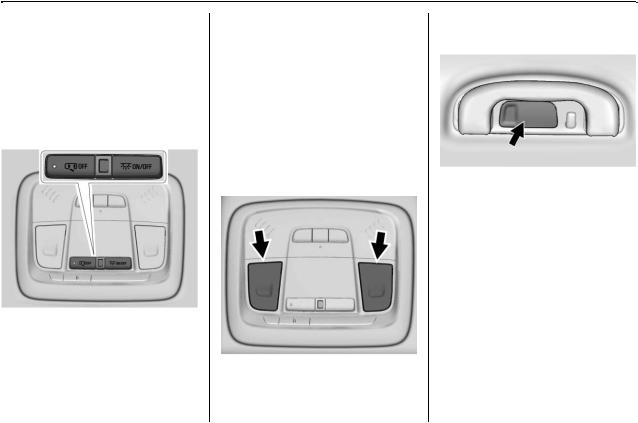
In Brief |
15 |
|
|
Press the control forward or rearward to move the steering wheel closer or away from you.
Do not adjust the steering wheel while driving.
Interior Lighting
Dome Lamps
The dome lamp controls are in the overhead console.
To operate, press the following buttons:
jOFF : Press to turn off the dome lamps when a door is open. An indicator light on the button will
turn on when the dome lamp override is activated. Press j OFF again to deactivate this feature and the indicator light will turn off. The dome lamps will come on when doors are opened.
+ ON/OFF : Press to turn the dome lamps on manually.
Reading Lamps
There are front and rear reading lamps.
The front reading lamps are in the overhead console.
Press the lamp lenses to turn the front reading lamps on or off.
The rear reading lamps are over the rear passenger doors.
Press the lamp lenses to turn the rear reading lamps on or off.
For more information on interior lighting, see Instrument Panel Illumination Control 0 148.

16 In Brief
Exterior Lighting
The exterior lamp control is on the instrument panel to the left of the steering column.
There are four positions.
O : Turns the exterior lamps off and deactivates the AUTO mode. Turn
to O again to reactivate the AUTO mode.
In Canada, the headlamps will automatically reactivate when the vehicle is shifted out of P (Park).
AUTO : Turns the exterior lamps on and off automatically depending on outside lighting.
; : Turns on the parking lamps including all lamps, except the headlamps.
5 : Turns on the headlamps together with the parking lamps and instrument panel lights.
See:
.Exterior Lamp Controls 0 144.
.Daytime Running Lamps (DRL) 0 145.
Windshield Wiper/Washer
With the ignition on or in ACC/ ACCESSORY, move the windshield wiper lever to select the wiper speed.
HI : Use for fast wipes.
LO : Use for slow wipes.
INT : Use for intermittent wipes. To adjust wipe frequency, turn the band up for more frequent wipes or down for less frequent wipes.
OFF : Use to turn the wipers off.
1x : For a single wipe, briefly move the wiper lever down. For several wipes, hold the wiper lever down.
f: Pull the windshield wiper lever toward you to spray windshield washer fluid and activate the wipers.
See Windshield Wiper/Washer 0 105.

In Brief |
17 |
|
|
Climate Controls
Dual Automatic Climate control System
The climate control buttons on the center stack and on the climate control display are used to adjust the heating, cooling, and ventilation.
|
Center Stack Climate Controls |
|||
1. |
Driver and Passenger |
6. |
MAX Defrost |
|
|
Temperature Displays |
7. |
Recirculation |
|
|
|
|||
2. |
Driver and Passenger |
8. |
Rear Window Defogger and |
|
|
Temperature Controls |
|||
|
|
Heated Outside Mirrors (If |
||
|
|
|
||
3. |
Driver and Passenger Heated |
|
Equipped) |
|
|
and Ventilated Seats (If |
9. |
Power (ON/OFF) |
|
|
Equipped) |
|||
|
10. |
AUTO (Automatic Operation) |
||
4. |
Fan Controls |
|||
|
|
|||
5. |
CLIMATE |
|
|
|
Climate Control Display
1.Outside Temperature Display
2.Driver and Passenger Temperature Controls
3.Fan Control
4.Sync (Synchronized Temperature)
5.A/C (Air Conditioning)
6.Climate Control Selection (Application Tray Button)
7.Air Delivery Mode Control
See Dual Automatic Climate Control
System 0 152.

18 In Brief
Transmission
Tap Shift
If equipped, Tap Shift allows you to shift an automatic transmission similar to a manual transmission. To use the Tap Shift feature:
1.When in D (Drive), pull back on the shift lever to enter
M (Manual Mode).
2.Use Tap Shift to manually shift the automatic transmission.
3.To exit, pull back on the shift lever to go from M (Manual Mode) back to D (Drive).
See Manual Mode 0 185.
Vehicle Features
Infotainment System
See the infotainment manual for information on the radio, audio players, phone, navigation system, and voice or speech recognition. It also includes information on settings.
Steering Wheel Controls
The infotainment system can be operated by using the steering wheel controls. See "Steering Wheel Controls" in the infotainment manual.
Cruise Control
5 : Press to turn cruise control on or off. A white indicator comes on in the instrument cluster.
RES+ : If there is a set speed in memory, press the control up briefly to resume to that speed or press and hold to accelerate. If cruise control is already engaged, use to increase vehicle speed.
SET− : Press the control down briefly to set the speed and activate cruise control. If cruise control is already engaged, use to decrease vehicle speed.

In Brief |
19 |
|
|
* : Press to disengage cruise control without erasing the set speed from memory.
See Cruise Control 0 193 and Adaptive Cruise Control 0 195 (if equipped).
Driver Information
Center (DIC)
The DIC display is in the instrument cluster. It shows the status of many vehicle systems.
y or z : Press to move up or down in a list.
S or T: Press S to open application menus on the left. Press T to open interaction menus on the right.
V : Press to open a menu or select a menu item. Press and hold to reset values on certain screens.
See Driver Information Center (DIC) 0 126.
Forward Collision Alert
(FCA) System
If equipped, FCA may help avoid or reduce the harm caused by front-end crashes. FCA provides a
green indicator, V, when a vehicle is detected ahead. This indicator displays amber if you follow a vehicle much too closely. When approaching a vehicle ahead too quickly, FCA provides a flashing red alert on the windshield and rapidly beeps or pulses the driver seat.
See Forward Collision Alert (FCA)
System 0 208.
Forward Automatic
Braking (FAB)
If the vehicle has Adaptive Cruise Control (ACC), it also has FAB, which includes Intelligent Brake Assist (IBA). When the system detects a vehicle ahead in your path that is traveling in the same direction that you may be about to crash into, it can provide a boost to braking or automatically brake the vehicle. This can help avoid or lessen the severity of crashes when driving in a forward gear.
See Forward Automatic Braking (FAB) 0 210.
Front Pedestrian Braking
(FPB) System
If equipped, the FPB system may help avoid or reduce the harm caused by front-end crashes with nearby pedestrians when driving in a forward gear. FPB displays an
amber indicator, ~, when a nearby pedestrian is detected directly ahead. When approaching a detected pedestrian too quickly,

20 In Brief
FPB provides a red flashing alert on the windshield and rapidly beeps or pulses the driver seat. FPB can provide a boost to braking or automatically brake the vehicle.
See Front Pedestrian Braking (FPB)
System 0 211.
Lane Keep Assist (LKA)
If equipped, LKA may help avoid crashes due to unintentional lane departures. It may assist by gently turning the steering wheel if the vehicle approaches a detected lane marking without using a turn signal in that direction. It may also provide a Lane Departure Warning (LDW) alert as the lane marking is crossed. The system will not assist or alert if it detects that you are actively steering. Override LKA by turning the steering wheel. LKA uses a camera to detect lane markings between 60 km/h (37 mph) and
180 km/h (112 mph).
See Lane Departure Warning (LDW) 0 215 and Lane Keep Assist (LKA) 0 216.
Lane Change Alert (LCA)
If equipped, the LCA system is a lane-changing aid that assists drivers with avoiding lane change crashes that occur with moving vehicles in the side blind zone (or spot) areas or with vehicles rapidly approaching these areas from behind. The LCA warning display will light up in the corresponding outside mirror and will flash if the turn signal is on. The Side Blind Zone Alert (SBZA) system is included as part of the LCA system.
See Side Blind Zone Alert (SBZA) 0 213 and Lane Change Alert (LCA) 0 214.
Rear Vision
Camera (RVC)
RVC displays a view of the area behind the vehicle on the infotainment display when the vehicle is shifted into R (Reverse) to aid with parking and low-speed backing maneuvers.
See Assistance Systems for Parking or Backing 0 204.
Rear Cross Traffic Alert
(RCTA) System
If equipped, the RCTA system uses a triangle with an arrow displayed on the infotainment display to warn of traffic behind your vehicle that may cross your vehicle's path while in R (Reverse). In addition, beeps will sound, or the driver seat will pulse.
See Assistance Systems for Parking or Backing 0 204.
Parking Assist
If equipped, Rear Parking
Assist (RPA) uses sensors on the rear bumper to assist with parking and avoiding objects while in
R (Reverse). It operates at speeds less than 8 km/h (5 mph). RPA may display a warning triangle on the infotainment display and a graphic on the instrument cluster to provide the object distance. In addition, multiple beeps or seat pulses may occur if very close to an object.
See Assistance Systems for Parking or Backing 0 204.

In Brief |
21 |
|
|
Automatic Parking
Assist (APA)
If equipped, the APA system helps to search for and maneuver the vehicle into parallel or perpendicular parking spots using automatic steering, DIC displays, and beeps. When the vehicle speed is below
30 km/h (18 mph), press O to enable the system.
See “Automatic Parking Assist (APA)” under Assistance Systems for Parking or Backing 0 204.
Power Outlets
The 12-volt power outlets can be used to plug in electrical equipment, such as a cell phone or MP3 player.
The vehicle has three power outlets:
.Under the front of the center console
.Inside the center console storage
.On the rear of the center console
Open the protective cover to use the power outlet.
The outlet is powered when the ignition is on or in ACC/ ACCESSORY, or until the driver door is opened within 10 minutes of turning off the vehicle. See Retained Accessory Power (RAP) 0 176.
See Power Outlets 0 106.
Universal Remote System
If equipped, this system provides a way to replace up to three remote control transmitters used to activate devices such as garage door openers, security systems, and home automation devices.
Read the instructions completely before attempting to program the Universal Remote system. Because of the steps involved, it may be helpful to have another person available to assist with programming the Universal Remote system.
See Universal Remote System 0 140.

22 In Brief
Sunroof
1.Sunroof Switch
2.Power Sunshade Switch (Rear)
3.Power Sunshade Switch (Sunroof)
On vehicles with a sunroof, the switches are on the overhead console.
The ignition must be on, in ACC/ ACCESSORY, or Retained Accessory Power (RAP) must be active. See Retained Accessory Power (RAP) 0 176.
Sunroof Switch
Express-Open/Express-Close : To express-open the sunroof, fully
press and release ~ (1). To express-close, fully press and release g(1). To stop the sunroof partway, press either switch a second time.
The sunshade opens automatically with the sunroof.
Open/Close (Manual Mode) : To open the sunroof, press and hold ~ (1). To close the sunroof, press
and hold g(1). To stop the sunroof partway, release the switch.
The sunshade opens automatically with the sunroof.
Vent : Press ~ (1) to vent the g(1) to close the
Power Sunshade Switch (Sunroof)
Open/Close : Press C (3) to open
the front sunshade. Press g (3) to close the front sunshade.
The vehicle has an automatic reversal system that stops the sunroof from closing when the reversal system detects an object in its path.
See Sunroof 0 49 and Rear Window
Sunshade 0 49.

In Brief |
23 |
|
|
eAssist Features
eAssist Overview
Vehicles with the 2.5L engine have eAssist, with additional features that contribute to increased efficiency.
Vehicles with eAssist have an automatic engine Stop/Start feature. This feature saves fuel by shutting the engine off when the vehicle is stopped. When the engine shuts off automatically, all the accessories will continue to operate normally. In very hot or cold conditions, the engine may not shut off. See
Starting the Engine 0 172.
There are two air conditioning settings available. The MAX setting maximizes cabin comfort. The ECO setting maximizes efficiency allowing more frequent, and longer engine stops than the MAX setting. See Dual Automatic Climate Control System 0 152.
Vehicles with eAssist include an AUTO STOP indicator on the tachometer. See Instrument Cluster 0 110.
The eAssist system uses a high voltage battery, which is cooled with air drawn from the vehicle interior.
The cold air intake for the battery is under the leading edge of the rear seat. The exhaust for warm air is in the trunk. Do not cover the intake or exhaust. See Battery - North America 0 247.
High Voltage Safety
Information
Vehicles with eAssist have a standard 12-volt battery and a high voltage battery. Only a trained service technician with the proper knowledge and tools should inspect, test, or replace the high voltage battery. See your dealer if the high voltage battery needs service.
In emergency situations, first responders can cut the two clearly labeled cut points in the engine compartment to disable the high voltage battery and air bag systems. Do not cut the high voltage cable.
Automatic Engine Stop/
Start Feature
Vehicles with eAssist have an automatic engine Stop/Start feature. After the engine is started and has reached operating temperature, this feature may cause Auto Stop which will turn the engine off when the brake pedal is applied and the vehicle comes to a complete stop. When the brake pedal is released, or the accelerator pedal is applied, the engine will restart. The engine will continue to run until the next Auto Stop.
AUTO STOP on the tachometer signifies that the engine is in Auto Stop mode. See Tachometer 0 112. Remember to put the transmission in P (Park) and turn the ignition off before exiting the vehicle.
See Starting the Engine 0 172.

24 In Brief
Regenerative Braking
Regenerative braking takes some of the energy from the moving vehicle and turns it into electrical energy.
This energy is then stored in the vehicle's high voltage battery system, contributing to increased fuel efficiency.
The system works whenever the accelerator pedal is released, and increases the energy captured as more brake pedal is applied.
Battery
This vehicle has a standard 12-volt battery. Refer to the replacement number on the original battery label when a new standard 12-volt battery is needed.
Vehicles with eAssist also have a high voltage battery. Only a trained service technician with the proper knowledge and tools should inspect, test, or replace the high voltage battery. See your dealer if the high voltage battery needs service. See
Battery - North America 0 247.
Service
Never try to do your own service on eAssist components. You can be injured and the vehicle can be damaged if you try to do your own service work. Service and repair of these high voltage components should only be performed by a trained service technician with the proper knowledge and tools. See
Doing Your Own Service Work 0 229.
Performance and
Maintenance
Traction Control/
Electronic Stability
Control
The Traction Control System (TCS) limits wheel spin. The system turns on automatically every time the vehicle is started.
.To turn off TCS, press and
release g on the center stack. i illuminates.
.Press and release g again to turn on TCS.
.To turn off both TCS and StabiliTrak, press and hold g until i and g illuminate.
.Press and release g to turn on both systems.
See Traction Control/Electronic
Stability Control 0 190.

In Brief |
25 |
|
|
Tire Pressure Monitor
This vehicle may have a Tire Pressure Monitor System (TPMS).
The low tire pressure warning light alerts to a significant loss in pressure of one of the vehicle's tires. If the warning light comes on, stop as soon as possible and inflate the tires to the recommended pressure shown on the Tire and Loading Information label. See
Vehicle Load Limits 0 166. The warning light will remain on until the tire pressure is corrected.
The low tire pressure warning light may come on in cool weather when the vehicle is first started, and then turn off as the vehicle is driven. This may be an early indicator that the tire pressures are getting low and the tires need to be inflated to the proper pressure.
The TPMS does not replace normal monthly tire maintenance. Maintain the correct tire pressures.
See Tire Pressure Monitor System 0 268.
Fuel
Regular Fuel
Use only unleaded gasoline rated 87 octane or higher in your vehicle. Do not use gasoline with an octane rating lower as it may result in vehicle damage and lower fuel economy. See Fuel 0 218.
E85 or FlexFuel
No E85 or FlexFuel
Gasoline-ethanol fuel blends greater than E15 (15% ethanol by volume), such as E85, cannot be used in this vehicle.
Engine Oil Life System
The engine oil life system calculates engine oil life based on vehicle use and displays the CHANGE ENGINE OIL SOON message when it is time to change the engine oil and filter.
The oil life system should be reset to 100% only following an oil change.

26 In Brief
Resetting the Oil Life System
1.Using the DIC controls on the right side of the steering wheel, display REMAINING OIL LIFE on the DIC. See Driver Information Center (DIC) 0 126. When remaining oil life is low, the CHANGE ENGINE OIL SOON message will appear on the display.
2.Press V on the DIC controls and hold down for a few seconds to clear the CHANGE ENGINE OIL SOON message and reset the oil life at 100%.
Be careful not to reset the oil life display accidentally at any time other than after the oil is changed. It cannot be reset accurately until the next oil change.
See Engine Oil Life System 0 237.
Driving for Better Fuel Economy
Driving habits can affect fuel mileage. Here are some driving tips to get the best fuel economy possible.
.Avoid fast starts and accelerate smoothly.
.Brake gradually and avoid abrupt stops.
.Avoid idling the engine for long periods of time.
.When road and weather conditions are appropriate, use cruise control.
.Always follow posted speed limits or drive more slowly when conditions require.
.Keep vehicle tires properly inflated.
.Combine several trips into a single trip.
.Replace the vehicle's tires with the same TPC Spec number molded into the tire's sidewall near the size.
.Follow recommended scheduled maintenance.
Roadside Assistance
Program
U.S.: 1-800-252-1112
TTY Users (U.S. Only): 1-888-889-2438
Canada: 1-800-268-6800
New Buick owners are automatically enrolled in the Roadside Assistance Program.
See Roadside Assistance Program 0 329.

Keys, Doors, and Windows 27
Keys, Doors, and
Windows
Keys and Locks
Keys . . . . . . . . . . . . . . . . . . . . . . . . . . . 27
Remote Keyless Entry (RKE)
System . . . . . . . . . . . . . . . . . . . . . . . 28
Remote Keyless Entry (RKE)
System Operation . . . . . . . . . . . . 28
Remote Vehicle Start . . . . . . . . . . 34
Door Locks . . . . . . . . . . . . . . . . . . . . 36
Power Door Locks . . . . . . . . . . . . . 38
Delayed Locking . . . . . . . . . . . . . . . 38
Automatic Door Locks . . . . . . . . . 39
Lockout Protection . . . . . . . . . . . . . 39
Safety Locks . . . . . . . . . . . . . . . . . . . 39
Doors
Trunk . . . . . . . . . . . . . . . . . . . . . . . . . . 40
Vehicle Security
Vehicle Security . . . . . . . . . . . . . . . . 42
Vehicle Alarm System . . . . . . . . . 42
Immobilizer . . . . . . . . . . . . . . . . . . . . 43
Immobilizer Operation . . . . . . . . . 43
Exterior Mirrors
Folding Mirrors . . . . . . . . . . . . . . . . . 45
Heated Mirrors . . . . . . . . . . . . . . . . . 45
Automatic Dimming Mirror . . . . . 45
Reverse Tilt Mirrors . . . . . . . . . . . . 45
Interior Mirrors
Interior Rearview Mirrors . . . . . . . 46
Automatic Dimming Rearview
Mirror . . . . . . . . . . . . . . . . . . . . . . . . . 46
Windows
Windows . . . . . . . . . . . . . . . . . . . . . . . 46
Power Windows . . . . . . . . . . . . . . . 47
Sun Visors . . . . . . . . . . . . . . . . . . . . . 49
Rear Window Sunshade . . . . . . . 49
Roof
Sunroof . . . . . . . . . . . . . . . . . . . . . . . . 49
Keys and Locks
Keys
{Warning
Leaving children in a vehicle with a Remote Keyless Entry (RKE) transmitter is dangerous and children or others could be seriously injured or killed. They could operate the power windows or other controls or make the vehicle move. The windows will function with the RKE transmitter in the vehicle, and children or others could be caught in the path of a closing window. Do not leave children in a vehicle with an RKE transmitter.
Convex Mirrors . . . . . . . . . . . . . . . . 44
Power Mirrors . . . . . . . . . . . . . . . . . . 45
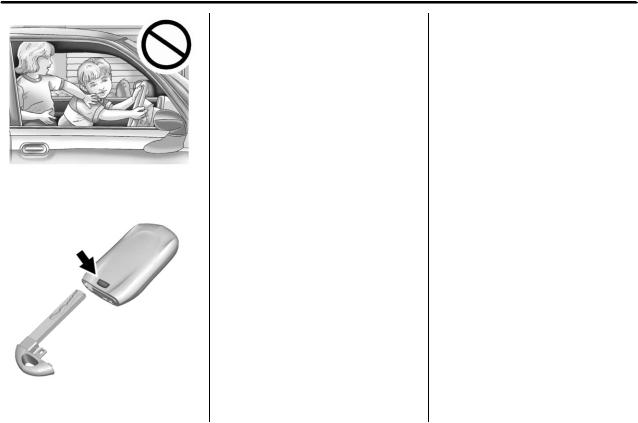
28 Keys, Doors, and Windows
The vehicle has the keyless ignition. The key can be used for the locks.
Press the button on the RKE transmitter to access the key.
If it becomes difficult to turn the key in a vehicle lock, inspect the key blade for debris. Periodically clean with a brush or pick.
See your dealer if a new key is needed.
With an active OnStar subscription, an OnStar Advisor may remotely unlock the vehicle. See OnStar Overview 0 339.
Remote Keyless Entry
(RKE) System
See Radio Frequency Statement 0 335.
If there is a decrease in the Remote Keyless Entry (RKE) operating range:
.Check the distance. The transmitter may be too far from the vehicle.
.Check the location. Other vehicles or objects may be blocking the signal.
.Check the transmitter's battery. See “Battery Replacement” later in this section.
.If the transmitter is still not working correctly, see your dealer or a qualified technician for service.
Remote Keyless Entry
(RKE) System Operation
The Keyless Access system allows for vehicle entry when the Remote Keyless Entry (RKE) transmitter is within 1 m (3 ft). See “Keyless Access Operation” later in this section.
The RKE transmitter functions may work up to 60 m (197 ft) away from the vehicle.
Other conditions can impact the performance of the transmitter.

Keys, Doors, and Windows 29
Q : Press to lock all doors.
The turn signal indicators may flash and/or the horn may sound on the second press to indicate locking. See Vehicle Personalization 0 133.
If the driver door is open when Q is pressed and enabled through vehicle personalization, all doors will lock and the driver door will immediately unlock.
If the passenger door is open when Q is pressed, all doors lock.
Pressing Q may also arm the theft-deterrent system. See Vehicle Alarm System 0 42.
K : Press to unlock the driver door. Press again within five seconds to unlock all doors. The RKE transmitter can be programmed to unlock all doors on the first button press. See Vehicle Personalization 0 133.
The turn signal indicators may flash to indicate unlocking. See Vehicle Personalization 0 133.
Pressing K will disarm the theft-deterrent system. See Vehicle Alarm System 0 42.
Memory seat positions may be recalled when unlocking the vehicle. See Memory Seats 0 55 and Vehicle Personalization 0 133.
X : Press twice quickly to release the trunk.
7 : Press and release to initiate vehicle locator. The exterior lamps flash and the horn chirps three times.
Press and hold 7 for at least three seconds to sound the panic alarm. The horn sounds and the
turn signals flash for 30 seconds until 7 is pressed again or the vehicle is started.
/ : If equipped, press Q and release and then immediately press
and hold / for at least
four seconds to start the engine from outside the vehicle using the RKE transmitter. See Remote Vehicle Start 0 34.
Keyless Access Operation
If equipped with a Keyless Access system, it allows for locking and unlocking the doors and accessing the trunk without removing the RKE transmitter from your pocket, purse, briefcase, etc. The RKE transmitter should be within 1 m (3 ft) of the trunk or door being opened. If the vehicle has this feature, there will be buttons on the outside of the door handles.
Keyless Access can be programmed to unlock all doors on the first unlock/lock button press from the driver door. See Vehicle Personalization 0 133.
